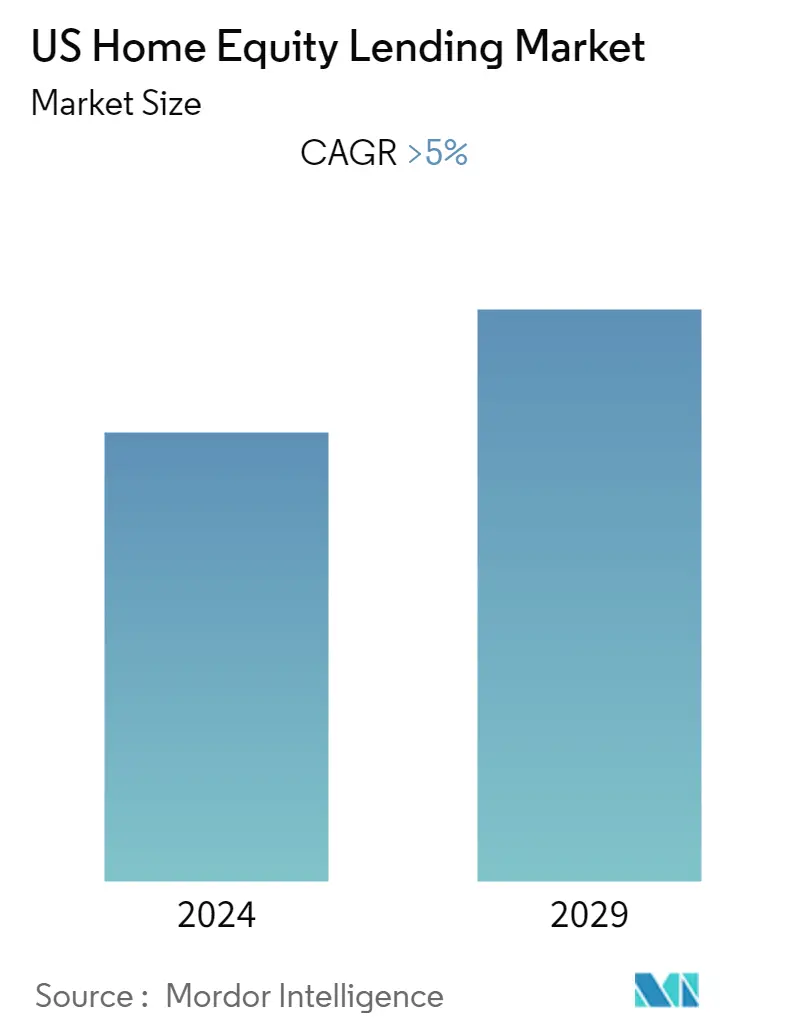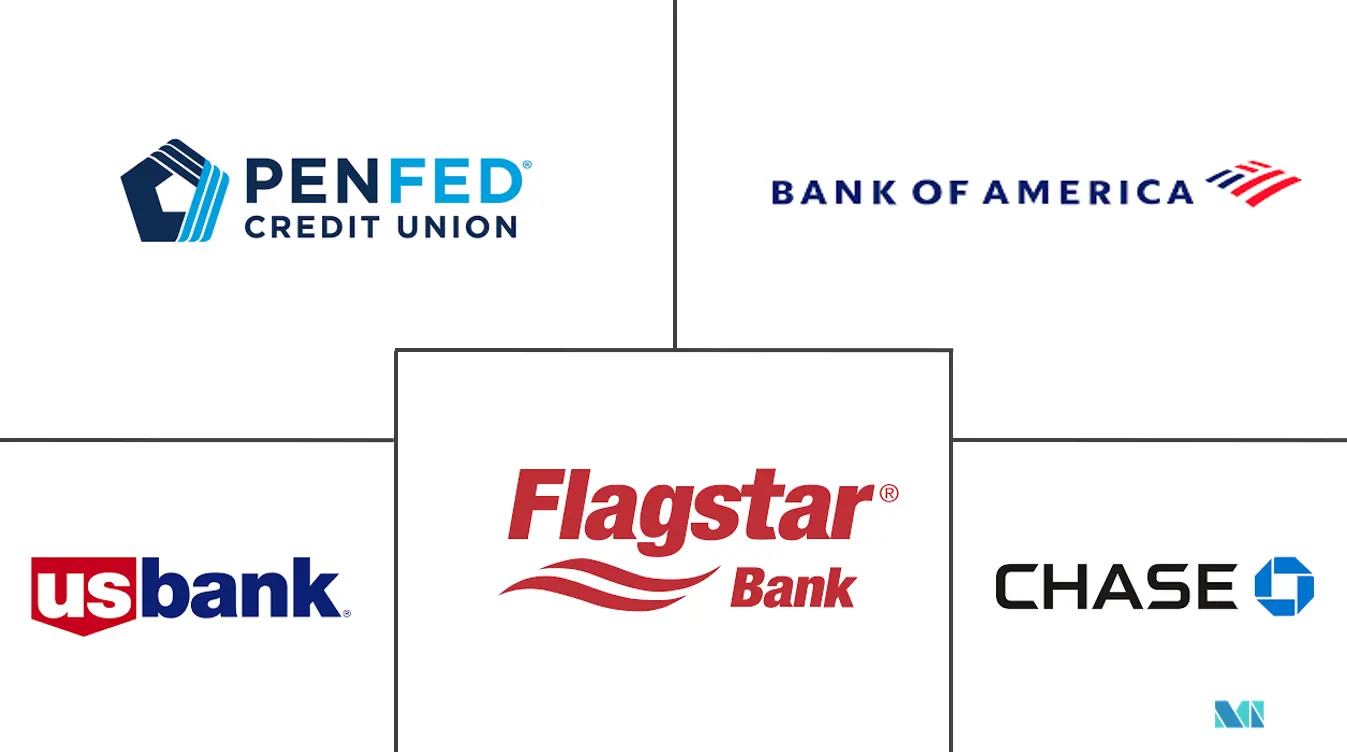Market Size of US Home Equity Lending Industry

| Study Period | 2020 - 2029 |
| Base Year For Estimation | 2023 |
| Forecast Data Period | 2024 - 2029 |
| Historical Data Period | 2020 - 2022 |
| CAGR | > 5.00 % |
| Market Concentration | Medium |
Major Players
*Disclaimer: Major Players sorted in no particular order |
US Home Equity Lending Market Analysis
The US Home Equity Market generated a revenue of over USD 29.31 trillion in the current year and is anticipated to register a CAGR of more than 5% for the forecast period.
The smart choices for US home equity lending are a mortgage and a credit union. There is an increasing need for reliable lenders for consumers' home equity lending in order to prevent scams and get a reasonable rate. Some of the key services offered by credit unions include accepting deposits, managing checking and savings accounts, dispensing credit and debit cards, and providing house loans. There is an increasing preference for credit unions among customers as it offer loans at the cheapest rate on credit products such as mortgages. Hence, such factors are expected to fuel the growth of this segment which, in turn, will drive the US home equity lending market during the forecast period.
The factors that drive the US market for home equity loans include rising home prices, popular home innovations, lower interest payments, and tax deductions when compared to other borrowing methods. The elements that operate as a lucrative potential for the US home equity loans industry include the strong demand for home equity loans and their superiority over alternative borrowing options.
Since the COVID-19 pandemic, the US home equity lending market has undergone a complete transformation. Mortgage applications became more difficult. Home equity loan borrowers limited loan availability and more stringent approval standards as a result of the mortgage lenders' lower risk exposure. Lenders are coping with demand and personnel challenges as a result of the coronavirus outbreak.
US Home Equity Lending Industry Segmentation
Home equity loans are a particular kind of loan where the borrower pledges the value of their house as security. This report aims to offer a detailed analysis of the US Home Equity Lending Market. It concentrates on the market dynamics, emerging trends in the segments and regional markets, and insights into various product and application types. Also, it focuses on the key players and the competitive landscape in the market. US Home Equity lending Market is segmented by type (Fixed rate loans and home equity lines of credit), by Service Providers (Commercial banks, Financial Institutions, Credit Unions, and other creditors), and by Mode (Online and Offline). The report offers market size and forecast in value (USD billion) for all the above segments.
| By Type | |
| Fixed rate loan | |
| Home equity lines of credit |
| By Service Providers | |
| Commercial banks | |
| Financial Institutions | |
| Credit Unions | |
| Other creditors |
| By Mode | |
| Online | |
| Offline |
US Home Equity Lending Market Size Summary
The US home equity lending market is experiencing a dynamic transformation, driven by factors such as rising home prices, innovative home improvements, and favorable tax deductions. The market is witnessing a growing preference for credit unions, which offer competitive rates on loans, including mortgages. This trend is fueled by the increasing demand for reliable lenders to mitigate scams and secure reasonable rates. The market's growth is further supported by the strong demand for home equity loans, which are perceived as superior to alternative borrowing options. The COVID-19 pandemic has reshaped the market, leading to stricter approval standards and challenges in meeting demand, as lenders navigate the complexities of a post-pandemic landscape.
Technological advancements are playing a pivotal role in the evolution of the US home equity lending market. The rise of technology-savvy homeowners has spurred a demand for digitalization in the loan process, with investments in mortgage automation and data-driven solutions becoming more prevalent. These advancements are enhancing the customer experience by streamlining loan origination and closing processes. Major players in the market, such as Bank of America, Flagstar Bank, PenFed Credit Union, Chase Bank, and US Bank, are leveraging technology to expand their market presence. Recent strategic moves, such as the acquisition of Spring EQ by Cerberus Capital Management and the partnership between VIU by HUB and Unison, highlight the ongoing efforts to innovate and lead in the home equity financing sector.
US Home Equity Lending Market Size - Table of Contents
-
1. MARKET DYNAMICS AND INSIGHTS
-
1.1 Market Overview
-
1.2 Market Drivers
-
1.2.1 Home Renovation Trends are Driving the Market
-
-
1.3 Market Restraints
-
1.3.1 Regulatory Changes are Restraining the Market
-
-
1.4 Market Opportunities
-
1.4.1 Digital Innovation will Create Opportunities to New Entrants
-
1.4.2 Refinancing Will Create Opportunities to New Entrants
-
-
1.5 Insights on Various Regulatory Trends
-
1.6 Insights on impact of technology and innovation
-
1.7 Industry Attractiveness - Porters' Five Forces Analysis
-
1.7.1 Threat of New Entrants
-
1.7.2 Bargaining Power of Buyers
-
1.7.3 Bargaining Power of Suppliers
-
1.7.4 Threat of Substitutes
-
1.7.5 Intensity of Competitive Rivalry
-
-
1.8 Impact of COVID-19 on the Market
-
-
2. MARKET SEGMENTATION
-
2.1 By Type
-
2.1.1 Fixed rate loan
-
2.1.2 Home equity lines of credit
-
-
2.2 By Service Providers
-
2.2.1 Commercial banks
-
2.2.2 Financial Institutions
-
2.2.3 Credit Unions
-
2.2.4 Other creditors
-
-
2.3 By Mode
-
2.3.1 Online
-
2.3.2 Offline
-
-
US Home Equity Lending Market Size FAQs
What is the current US Home Equity Lending Market size?
The US Home Equity Lending Market is projected to register a CAGR of greater than 5% during the forecast period (2024-2029)
Who are the key players in US Home Equity Lending Market?
Bank of America, Flagstar Bank, PenFed Credit Union, Chase Bank and US Bank are the major companies operating in the US Home Equity Lending Market.

